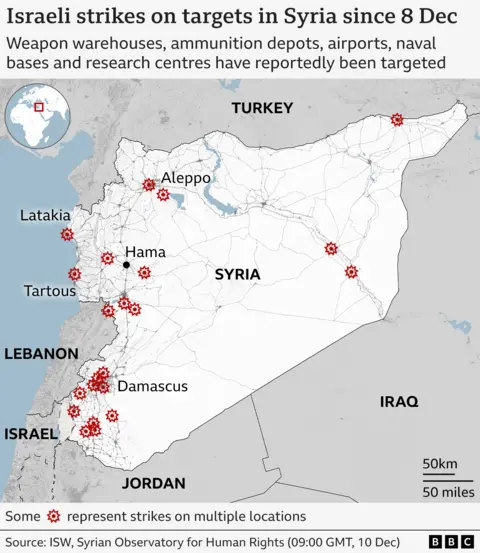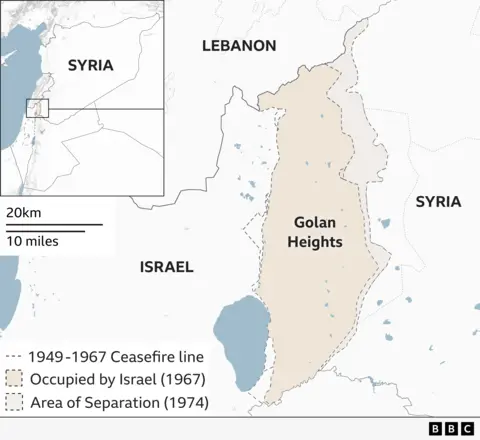Israel confirms attack on Syrian naval fleet
In a statement, the Israel Defense Forces (IDF) said its ships struck the ports at Al-Bayda and Latakia on Monday night, where 15 vessels were docked.

KATHMANDU: Israel has confirmed it carried out attacks on Syria’s naval fleet, as part of its efforts to neutralise military assets in the country after the fall of the Assad regime.
In a statement, the Israel Defense Forces (IDF) said its ships struck the ports at Al-Bayda and Latakia on Monday night, where 15 vessels were docked.
The BBC has verified videos showing blasts at the port of Latakia, with footage appearing to show extensive damage to ships and parts of the port.
The IDF also said its warplanes had conducted more than 350 air strikes on targets across Syria, while moving ground forces into the demilitarised buffer zone between Syria and the occupied Golan Heights.
Earlier, the UK-based Syrian Observatory for Human Rights (SOHR) said it had documented more than 310 strikes by the IDF since the Syrian government was overthrown by rebels on Sunday.
In a statement, Israel’s Defence Minister Israel Katz said the IDF was aiming to “destroy strategic capabilities that threaten the State of Israel”.
He added that the operation to destroy the Syrian fleet had been a “great success”.
The IDF said a wide range of targets had been struck – including airfields, military vehicles, anti-aircraft weapons and arms production sites – in the Syrian capital, Damascus, as well as Homs, Tartus and Palmyra.
It also targeted weapon warehouses, ammunition depots and “dozens” of sea-to-sea missiles.
It added that it had done so to prevent them “from falling into the hands of extremists”.
In a video message, Israeli Prime Minister Benjamin Netanyahu told the Syrian rebel group that ousted President Bashar al-Assad, Hayat Tahrir al-Sham (HTS), that Israel would “respond forcefully” if they allow Iran to “re-establish itself in Syria”.
He has previously expressed a desire for peaceful ties with the new Syrian government, and cast its interventions as defensive.
Rami Abdul Rahman, the founder of the SOHR, described the impact of the strikes as destroying “all the capabilities of the Syrian army” and said that “Syrian lands are being violated”.
Meanwhile, the IDF also confirmed it had troops operating in Syrian territory beyond the buffer zone bordering the Israeli-occupied Golan Heights.
The IDF acknowledged that its troops had entered Syrian territory but told the BBC that reports of tanks approaching Damascus were “false”.
It said some troops had been stationed within the Area of Separation that borders the Israeli-occupied Golan Heights “and then a few additional points”.
“When we say a few additional points, we’re talking the area of the Area of Separation, or the area of the buffer zone in vicinity,” IDF spokesperson Nadav Shoshani told the BBC.
BBC Verify has geolocated an image of an IDF soldier standing just over half a kilometre beyond the demilitarized buffer zone in the Golan Heights, inside Syria on a hillside near the village of Kwdana.
On Monday, the Israeli military released photos of its troops who crossed from the Israeli-occupied Golan Heights into the demilitarised buffer zone in Syria where UN peacekeepers are based.

The IDF seizure of Syrian positions in the buffer zone was a “temporary defensive position until a suitable arrangement is found”, Israeli Prime Minister Benjamin Netanyahu said on Monday.
“If we can establish neighbourly relations and peaceful relations with the new forces emerging in Syria, that’s our desire. But if we do not, we will do whatever it takes to defend the State of Israel and the border of Israel,” he said on Monday.
Turkeys foreign ministry condemned Israel’s entry into the buffer zone, accusing it of an “occupying mentality” during a “sensitive period, when the possibility of achieving the peace and stability the Syrian people have desired for many years has emerged”.
This buffer zone, also known as the Area of Separation was set up as part of Israel’s ceasefire agreement with Syria in 1974 to keep Israeli and Syrian forces separated, following Israel’s earlier occupation of the Golan Heights.
Israel unilaterally annexed the Golan in 1981. The move was not recognised internationally, although the US did so unilaterally in 2019.

Asked about the IDF strikes on Monday night, Israeli Foreign Minister Gideon Saar said Israel was concerned only with defending its citizens.
“That’s why we attack strategic weapons systems like, for example, remaining chemical weapons or long-range missiles and rockets in order that they will not fall into the hands of extremists,” he said.
On Monday, the UN’s chemical watchdog warns authorities in Syria to ensure that suspected stockpiles of chemical weapons are safe.
It is not known where or how many chemical weapons Syria has, but it’s believed former President Assad kept stockpiles.
Israel’s attacks come after Syrian rebel fighters captured the capital, Damascus, as Assad fled the country, reportedly for Russia. He, and before him his father, had been in power in the country since 1971.
Forces led by the Islamist opposition group HTS entered Damascus in the early hours of Sunday, before appearing on state television to declare that Syria was now “free”.
-BBC









